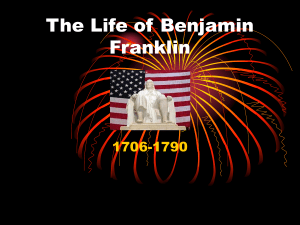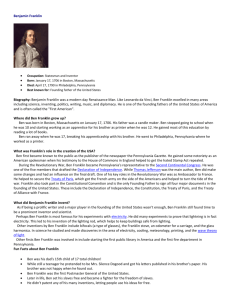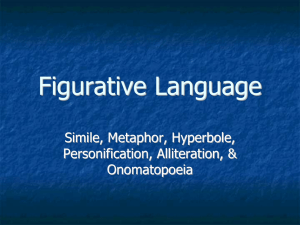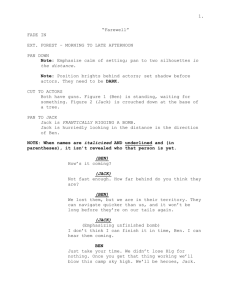How Ben Franklin Stole the Lightning
advertisement
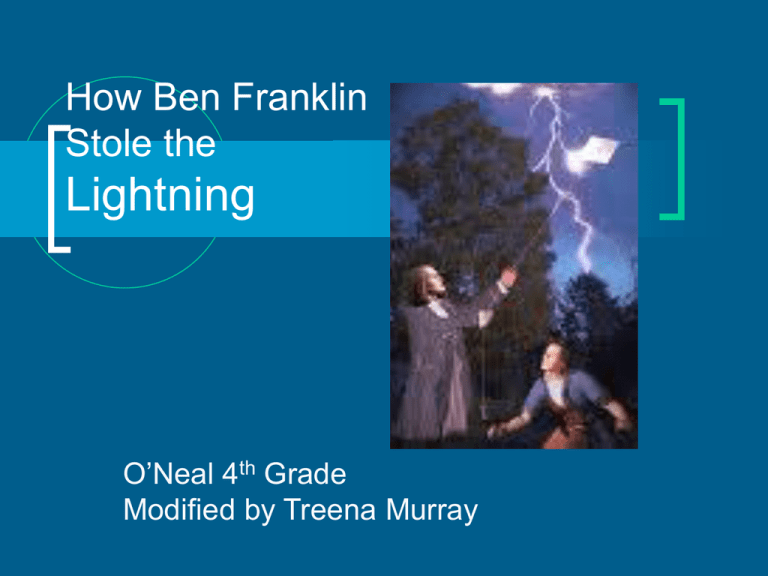
How Ben Franklin Stole the Lightning O’Neal 4th Grade Modified by Treena Murray Genre: Biography A biography is a story about the life of a real person written by someone else. Biographies tell you what character traits the subject had. •http://gardenofpraise.com/ibdfrank.htm •http://bensguide.gpo.gov/benfranklin/ •http://www.ushistory.org/franklin/info/index. htm •http://kids.yahoo.com/directory/Around-theWorld/Countries/UnitedStates/History/Colonial-Life-(15851783)/Biographies/FoundingFathers/Franklin--Benjamin Vocabulary hilarious – very funny convinced – caused a person to believe or do something mischief – conduct that may seem playful but causes harm or trouble independence – Freedom from the control of another or others (come in) handy – within reach, nearby; easy to use dizzy – having the feeling of spinning and being about to fall whirlwind – a current of air that moves forward with great force nowadays – in the present time Vocabulary: Story Words eclipse: a shadow that moves across the sun or the moon odometer: a meter that tells how far a vehicle has traveled scurvy: a disease that causes weakness, joint pain, and dental problems scepter: a staff carried by a king or queen to represent power tyrants: cruel or unfair rulers Vocabulary: Words in Context handy, convinced, dizzy, hilarious, independence, mischief, nowadays, whirlwind Jack was ________ that he could use strong wind to power his bike and never be late for school again. He aimed to create a ______ using air blown by a strong current. I thought that the idea was _________, but Jack was famous for his creativity. He couldn’t be talked out of the idea. Words in Context Jack always kept many different objects nearby as he worked. He had boxes, bottles, and even large cans, and he built his inventions out of whatever was ________. Since Jack was often getting himself into_____, nobody paid much attention to him. His actions showed his ________ from rules and the regular ideas of others. However, when I looked out the window and saw Jack wrestling with a garbage can, I was afraid that he would get _______ and fall into the street. I ran to help him, but not before the garbage can took off down the street, leaving Jack in a heap on the ground. ____________, Jack just walks to school. Words in Context Dictionary: Idioms An idiom is an unusual way to say something. Idioms are words or groups of words that cannot be understood by figuring out the meaning of each word. Example: Pulling my leg This group of words means “to trick or to tease” Practice: Idioms Practice: Eye on Idioms Dictionary: Idioms know like a book get wind of stick one’s neck out draw the line give someone a piece of one’s mind pull his leg put your foot down Phonics: Decode with /ar/ and /or/ An r-controlled vowel is a vowel followed by the letter r. One rcontrolled vowel is ar, as in car. After w, ar usually represents /or/ as in war. Another r-controlled vowel is or, as in shore. Comprehension: Generate Questions Problem and solutions are important parts of most stories. Asking yourself questions as you read can help you understand problem and solution. When you begin reading a biographical sketch, you should ask yourself, “What problem does the subject face?” or “What does the subject want or need to do?” These questions will help you identify the problem. Once the problem is identified, look for actions that the subject takes to solve the problem. Comprehension: Problem and Solution Problem and Solution Chart Problem Reread page 222223 and complete a Problem and Solution Chart Action Action Solution Comprehension Practice Problem and Solution Fact and Opinion Comprehension: Fact and Opinion A fact is a statement that can be proved as true. Writers use facts when writing informational texts about various subjects. They may also use facts to support their opinions. An opinion is a statement that tells what someone thinks or believes. Signal words and phrases, such as I think, I believe, or I feel may alert readers to opinions. Strong adjectives that are likely to be expressions of the author’s feelings, such as ugly, exciting, terrible, or scary can also be clues that an opinion is being stated. Fluency: Repeated Reading: Tempo Pay attention to the correct pronunciation of odometer and bifocals Slow your tempo when you read the sentences in which these words appear. He also invented an odometer that told how far he had ridden to deliver the mail. And the first clock with a second hand. And he even thought up daylight saving time. Then he invented bifocals so older folks could see up close and far away without changing glasses. Almanacs An almanac is a book that provides facts on many different subjects. In an almanac, you can find how high the world’s tallest mountains, are, how fast Olympic athletes can run, or how many people live in your state. Information in almanacs changes frequently and must be rewritten each year. Poetry A Concrete Poem has words arranged in the shape of the thing it describes. Figurative Language uses words to evoke mental images. This includes similes, metaphors, and other words that create images in the reader’s mind. Alliteration is the repetition of the dame consonant sound in a series of words. Alliteration Quia - Alliteration Literary Device: Imagery When authors use descript words (ugly, pretty, creepy,) and phrases to create pictures or images in the reader’s mind, he or she is making use of imagery. As you read stories, make some notes of how the author uses imagery. On page 230, the author uses an idiomatic expression “lickety-split” to create an image in the reader’s head. What image comes to your mind when you hear “lickety-split”? Reflection: Day 1 Re-read page 222-223. What does independence mean in the story? Give two details or clues from the story that helps you understand the meaning. Reflection: Day 2 Re-read page 230-231. For what problem did Ben Franklin invent two solutions? What were the solutions? What were the reasons that Ben Franklin had this problem in the first place? Reflection: Day 3 Re-read page 232. What does the author mean by the idiom “everybody and his brother and sister”? Reflection: Day 4 Re-read page 236-237. What actions did Ben Franklin take to start solving the problem of fires caused by lightning? Reflection: Day 5 What was Ben Franklin’s most famous invention, and what problem did it solve? Use story details to support your answer.
